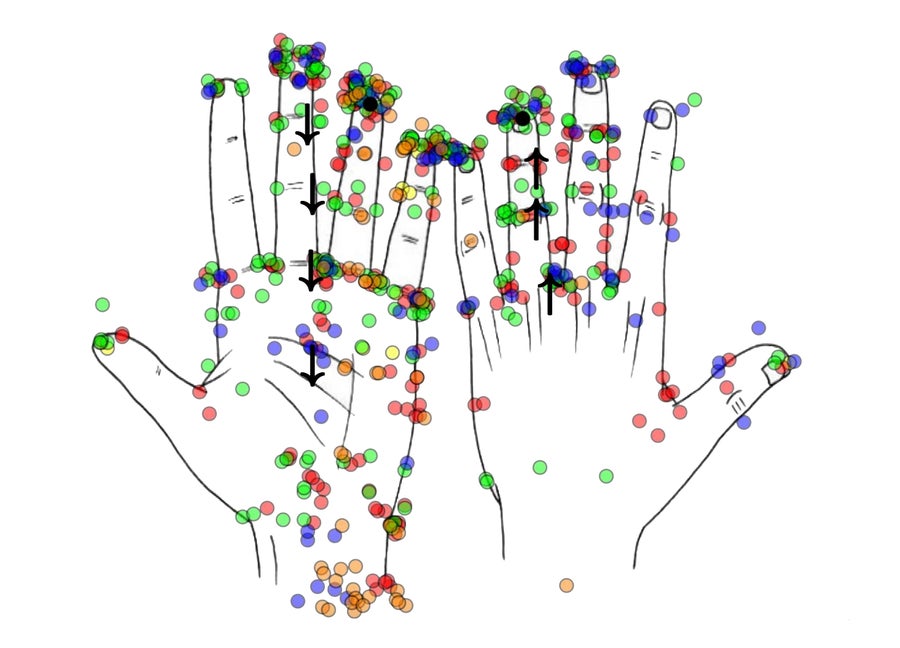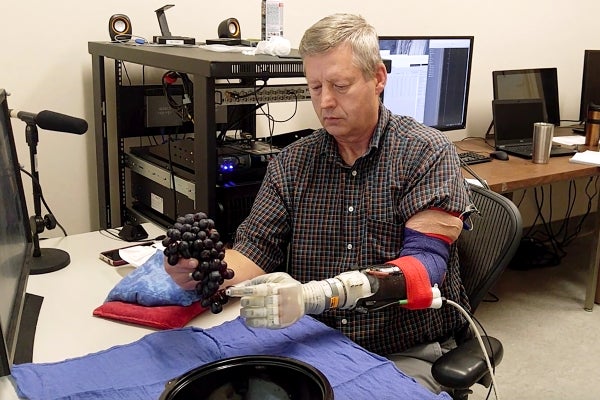Your eyes may be reading this, but you likely used your hands to get here. Every day your fingers, wrists and forearms conduct the symphony of motor movements that allow you to click a mouse, type on a keyboard or swipe a screen. But what if you lost your hand? What kind of machine could restore your abilities to grip, click, tap or touch?
What Happened?
In a new study, a group of researchers at the University of Utah have re-engineered a prosthetic system to let a man whose hand was amputated feel a wide range of sensations, helping him physically grasp a variety of delicate objects, from a glass of wine to a single grape. Although other prosthetics have enabled wearers to receive sensory feedback, the modified system ramps up the subtle detection of sensation in the hand.
On supporting science journalism
If you're enjoying this article, consider supporting our award-winning journalism by subscribing. By purchasing a subscription you are helping to ensure the future of impactful stories about the discoveries and ideas shaping our world today.
How They Did It
“A lot of people think of touch as one sense, but touch is actually comprised of many different senses,” says Jacob George, a postdoctoral researcher who led the study. “There are sensors in your hand for pain, for temperature, for vibration, for pressure—and so what we’re doing is identifying each one of those little sensors.”
The researchers isolated 119 “sensory precepts,” or perceptions, from their subject. To do so they first implanted electrodes into the peripheral nerves on his forearm, crafting a kind of replacement wiring system for the lost hand. Then they stimulated different circuits inside each electrode to figure out what triggered each sensory precept. These were then mapped onto the prosthetic hand to create a “really good approximation of the same information that [the subject] would be getting from their natural hand,” George says.

This diagram shows the 119 different "sensory precepts" researchers found by stimulating the various circuits in each electrode implanted in the subject’s forearm. The color code shows feelings of vibration (red), pressure (green), pain (blue), tightening (orange), movement (arrows), tapping (yellow), and buzzing (black). Credit: University of Utah Center for Neural Interfaces
Relevant History
Humans have been using prostheses for thousands of years; for most of that history, artificial limbs have consisted of either solid attachments or relatively crude mechanical structures. In recent decades prostheses have become increasingly complex, using lighter and stronger composite materials and incorporating microprocessors and automated control systems.
But a big challenge remains: bridging the sensory gap between amputee and replacement limb. Research groups at institutions including M.I.T., Case Western Reserve University and University of Pittsburgh are using neural interfaces to listen into the body’s signals and translate complex human motor control into machine movement. In the new study, researchers started with the Deka arm—a bionic prosthesis that can connect to an amputee’s neural system and that the FDA approved as a medical device in 2014.
Interesting Detail
The researchers used a kind of challenge round in the study to ensure that the touch sensation was coming just from the prosthesis, and that the subject’s feelings were not influenced by seeing the hand touch things. They blindfolded the subject, covered his ears and placed the bionic arm on a table a few feet away. They then asked him to judge whether various unseen objects (such as a foam or plastic block) were “soft” or “hard” by grasping them blindly with the bionic hand.
Next the researchers wanted to increase the speed with which the subject could feel the texture of the unseen object. Previous research from collaborators at the University of Chicago had created a model of how nonhuman primates’ brains reacted to touching a surface with their paws. For the new study, the researchers tapped this information to adjust how the subject would perceive the object he was grabbing. The result, according to George, was “a huge increase in performance.”
Caveats
This kind of prosthesis is not just expensive—George estimates the per-unit cost at somewhere between $100,000 and $200,000—it is not even available yet. The researchers hope to do take-home trials and apply for FDA approval within the next few years. So far the University of Utah team has successfully implanted the electrodes and arms on just eight patients.
And then there is the question of who pays. George says the team is trying to position the feeling prosthesis as a necessary medical device that insurance would cover. It is not guaranteed, however, that insurance companies will pay for even simpler devices in use today.
Still, George remains optimistic. “It’s hard to put a price tag on when you see this individual reach out and shake hands with his wife and feel her for the first time,” he says. “That’s going to be something that’s hard for us to quantify, but it’s something we need to show the insurance companies.”
